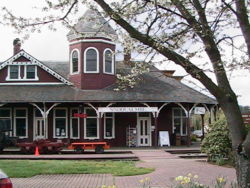Northwest Railway Museum
The Northwest Railway Museum is a heritage railway and railroad museum located in Snoqualmie, Washington.
The Museum was founded in 1957 as the Puget Sound Railway Historical Association and took its current name in September 1999. The mission of the organization is to develop and operate an outstanding railway museum where the public can see and understand the role of railroads in the development of the Pacific Northwest, and experience the excitement of a working railroad.
The Museum owns the Snoqualmie depot built in 1890, 3.5 miles of railroad right-of-way, and 5.5 miles of the former Northern Pacific Railway North Bend branch. This railway was built in 1889 as the Seattle, Lake Shore and Eastern Railway (SLSE) and was Seattle's response to the Northern Pacific's selecting Tacoma as their terminus. Ironically, the SLSE was later taken over by the Northern Pacific.
The museum's collection also includes a variety of railway cars and locomotives that document that development of the railway in Washington from the 1880s through the 1960s. It also includes a 3,000-volume library and archives that focus on the history of railroads in the Northwest, and on technical and other engineering aspects of railroading.
The museum operates an interpretive railway program called the Snoqualmie Valley Railroad. This 5-mile common carrier railroad allows museum visitors to experience a train excursion aboard antique railroad coaches through the Upper Snoqualmie Valley. Trains operate on Saturdays and Sundays from April through October and in December, and carry over 47,000 passengers per year.
In August 2006 the Museum dedicated the new Conservation and Restoration Center (CRC), phase one of the Railway History Center. The CRC is a place to perform collection care on large rail artifacts including locomotives, coaches, and freight cars. It features 8,200 square feet, two full length inspection pits, and will be used to perform many functions once conducted in railroad backshops.







